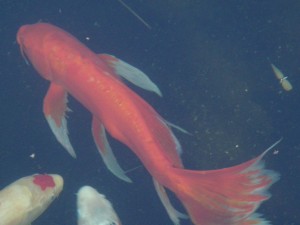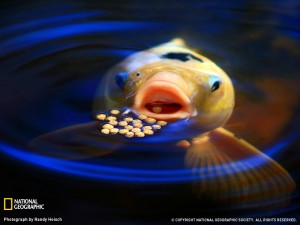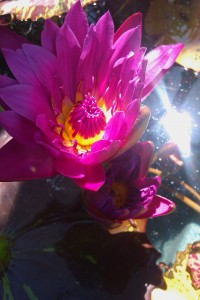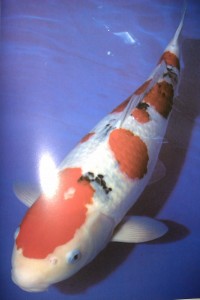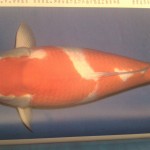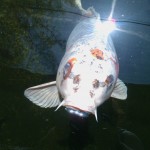Koi keeping is an important part of Pond Care and stress is an impending part of it. We all go through stress in our lives to being uncomfortable and new to something. Fish living out in nature would simply swim away from stressful conditions, but when they are confined in a pond or tank there is no way for them to swim away. Ammonia levels can get too high and this can cause them a lot of stress. Fish have a hard time dealing with change in their environment, including temperature. That is why when you move any fish from one water source to another they need to be acclimated before being put in. This goes for pH, hardness and alkalinity of its new home.
Feeding Fish
Feed fish what they want observe them, listen to the fish. They will let you know whether they are hungry or not. 15-20 minutes after placing the food in the water for the fish to eat, there should be no floating food left. If there is food, you have fed them too much.
Fish are cold-blooded animals. Their metabolism is based on the temperature of the water they live in. Warmer water creates faster metabolisms. Fish will eat more and need more food to survive. Colder water creates slower metabolisms in fish. They will eat less food. In fact, at 50 F / 30 C you stop feeding goldfish and koi. Below 50 F / 30 C if they do swallow food, the food will spoil before it passes out of their long intestinal track. This leads to all types of problems sickness, diseases, digestive problems, etc. Note that normally they will not eat when it is this cold and the uneaten food will only spoil, clog and over load your filter system, disturb the pond balance and possibly create an unhealthy and detrimental situation. Thus note at 50 F / 30 C and below DO NOT FEED YOUR FISH!
Start feeding once a day as the temperature warms in the spring. When it warms, koi can be fed multiple times a day. As the weather cools in the fall, gradually slow down on the quantity till you stop at 50 F.
Koi/Carp are bottom-feeding fish in nature. The barbs on either side of their mouths are used to tactilely feel along the bottom of a lake for food. They are omnivores. An omnivore is a kind of animal that eats either other animals or plants. Naturally, their diet would consist of worms, crustaceans, plant life, etc. We have trained koi to come to the surface with floating food for our own enjoyment.
Koi food companies are doing their best to create dietary mixtures in their foods and for the most part they are doing a good job. And yet there is still a belief that the dietary needs of koi are still most optimally met by augmenting a variety of foods some proteins, plants, starch, etc. This can include not just pelleted/processed foods, but also fruit sliced oranges, grapefruit, watermelon, grains -rice, wheat, bread.
Japanese Koi
The Japanese Koi are world wide known as beautiful fish composed of brilliant colors and markings. People who own these fish can tell you how wonderful it is to be part of their lives. There is a mysterious past that surround this awesome fish. A lot of people still wonder where they have originated from.
Koi is a Japanese name meaning Carp, but the original word comes from the latin word Cyprinus Carpio meaning Carp. Many people believe the Koi came from Japan, but it is understood that Japanese Koi have come from the waters of the Caspian Sea and around China. There are records of carp fossils found in China dating back 20 million years and showing early accounts of the first color mutations being bred in China.
It is unclear as to where Koi are from, but there are a lot of stories that Koi have been brought to Japan by the Chinese invasion. Another says that Japans emperor had kept Koi in 200 AD. The history of Japanese Koi is pretty vague. As to what really happed between the 2nd and the 17th century is an ongoing exploration still today.
MYTHOLOGY of the LILY
Koi Colors and Patterns
Taisho Sanke
Sanke, are another popular koi, along with Kohaku and Showa. Sanke means tri-color, the three colors being red, white and black. In Japanese characters the word Sanke is also read as Sanshoku, the term used in early works on koi.” (Kin Matsuba pg.136) Hobbysts in many countries love the Sanke because of their extensive variety of designs.
Taisho is in reference to the period when the Sanke was first recorded in Japanese history. This was between 1912 and 1926. “Over the past 60 years the markings of the Sanke have changed quite dramatically. The first Sanke were very striped in appearance , but todays show winning Sanke is a beautifully balanced koi whose sumi, although deeper in shade, is more delicate in appearance than that of its ancestors.” (Kin Matsuba pg.136)
Matsuba, Kin-“The Tetra Encyclopedia of Koi” By, Kin Matsuba
Koi Colors and Patterns
In Koi keeping, hobbyist always begin with a Kohaku and end with a Kohaku. When new hobbyists begin, they always overlook the Kohaku koi for its simplicity; looking to much like goldfish. However, they always end up appreciating the colors and patterns of the Kohaku and turn to this simple beautiful koi.
“The Kohaku share the colors of both the Japanese flag and the symbol of that country, the Tancho crane, but it is much more difficult to find a prize Kohaku than a show winner of any other variety. In Japan, to own a good Kohaku is the ambition of every koi-keeper.” (Kin Matsuba pg.128)
Matsuba, Kin-“The Tetra Encyclopedia of Koi” By, Kin Matsuba
Koi Facts
Breeding Age: Females over 3 years and Males at least 2 Years
Sexing koi smaller than 10 inches in length is impossible, because they are sexually immature. Once the koi grow to mature size, the ovaries in females and testes in males begin to develop. Female koi are way easier to spot because the ovaries are a much larger organ than the testes and it makes the females belly look more plump rather than how the male has a torpedo shape.
The males develop breeding tubercles on the head and pectoral fins when they are ready to spawn. The breeding tubercles materialize as raised spots making it look like Ichthyophtirius, which is a white spot. The tubercles are rough when touched and are in rows. The male koi nudge the female with his head and fins to persuade her spawn with this breeding ritual.
Koi Facts
Life Span of Koi: 60+ Years
Great info from Ozarkkoi!
Determining the age of a koi fish, also known as nishikigoi, is not an easy task. Some signs to take into consideration are the variety, coloration, appearance and size of the koi fish in question.Lastly, the size of your koi fish will help determine its age. Mature nishikigoi can reach 36″ or more in length. If your koi fish is considerably smaller, it is younger in age or its growth has been stunted.
Koi Photo!
We found this site today that features photos of Koi Fish. You really owe it to yourself to see it for yourself! Check out Muza-chan’s Gate to Japan! We hope you enjoy it as much as we do!
